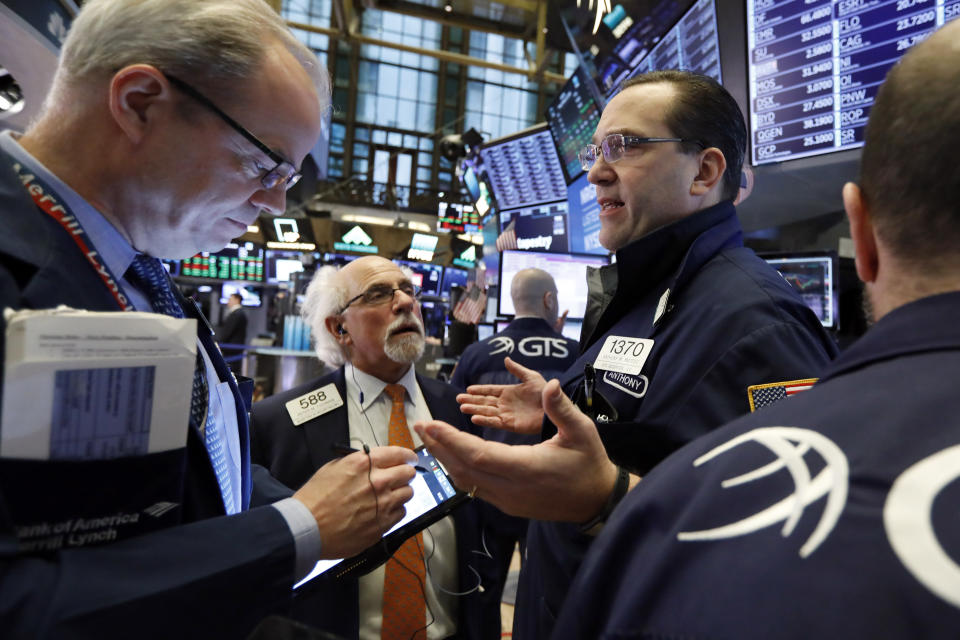Stocks end higher as Trump fuels hopes for flexible China trade deadline
U.S. stocks eked out gains on Tuesday as investors navigated mixed corporate earnings results and signals of a possible extension for a deadline to reach a trade deal with China.
The S&P 500 (^GSPC) rose 0.15%, or 4.16 points, as of market close, with the Consumer Staples sector leading advances as shares of Walmart (WMT) rose. The Dow (^DJI) edged up 0.03%, or 8.07 points, while the Nasdaq (^IXIC) rose 0.19%, or 14.36 points.
The three major indices gained Tuesday afternoon after President Donald Trump said that March 1 was not a “magical date” to have to complete trade negotiations with China, according to multiple reports. It was previously expected that the U.S. rate of tariffs on Chinese-made goods would increase after March 1, based on a truce Trump and Chinese President Xi Jinping reached in December. The latest round of trade negotiations took place Tuesday in Washington, following a series of talks last week in Beijing.
Elsewhere, stronger-than-expected earnings results helped some companies outperform the broader market on Tuesday.
Shares of Walmart (WMT) rose after the company reported fiscal fourth-quarter results on Tuesday morning that exceeded expectations on the top and bottom lines. The company also posted strong year-over-year increases in comparative same-store sales and e-commerce sales. The positive holiday quarter results from the world’s largest retailer subverted concerns of a slowdown in the sector after government data last week pointed to the largest decline in retail sales in nearly a decade in December.
Though this earnings season has seen sprigs of positive surprises, results have largely come in soft compared to last year. This is in part a result of tough comparables over last year, when tax code changes added up to 8% to 2018 earnings per share, Credit Suisse noted.
“Investors have expressed concern about the likelihood of an ‘earnings recession’ in 2019,” Goldman Sachs analyst David Kostin wrote in a note. But these concerns may be overblown, Kostin asserted. He believes weak profit growth will turn around in the second half of 2019 and expects to see 6% S&P 500 earnings growth for the full-year 2019, or 200 basis points ahead of bottom-up consensus estimates for this year’s earnings growth.
“The market has already priced the slowdown in earnings growth and revisions have troughed. Earnings revisions drive equity prices,” Kostin said. “In recent weeks however, the market rebound has accompanied an improvement in earnings sentiment. Looking forward, we believe it would require another wave of negative revisions for earnings to weigh on the S&P 500.”
U.S. stocks could also take a hit from “further deterioration in macroeconomic data,” Kostin added.

With recent economic data for Asia and the Eurozone suggesting weakening growth in some of the world’s largest economies, such a deterioration would not be out of the question. And this could spill over to equity performance.
“Stock markets have generally defied the recent slew of weak economic data, powering ahead regardless,” economists from Capital Economics wrote in a note Tuesday. “But we’re sticking to our view that they will eventually succumb, as evidence that the global economy is weakening continues to accumulate.”
Individual companies have begun to cite the global economic landscape as cause for weaker-than-expected results. John Flint – CEO for HSBC (HSBC), which missed expectations for fourth-quarter earnings – on a call with investors Tuesday said, “Uncertainty and risk in the global economy is higher, relating mainly to the UK economy, global trade tensions and the future path of interest rates.” And Walmart, even amid its better-than-expected fourth-quarter results, said that “a slower economic environment affected sales growth” in China, where the retailer posted a 0.2% decline in same-store sales.
ECONOMY: Homebuilder sentiment rose in February, Fed’s Mester speaks on monetary policy
Homebuilder sentiment rose more-than-expected in February, according to the results of the monthly National Association of Home Builders/Wells Fargo Housing Market Index released Tuesday. The headline index rose 4 points to 62 in February, outpacing consensus economist expectations for a reading of 59, according to Bloomberg data. Readings above 50 indicate positive sentiment. The better-than-expected results come amid the Federal Reserve’s latest decision to pause on interest rate hikes in its January policy decision, which has helped support confidence among buyers.
Federal Bank of Cleveland President Loretta Mester, the first of a series of Fed officials delivering remarks this week, said in a speech at the University of Delaware that the benchmark interest rate may rise slightly this year from its current band of between 2.25% to 2.5%. Her remarks, however, still echoed the “wait and see” themes that central bank officials have been telegraphing as of late, and she indicated that officials would consider medium-run forecasts “before making any further adjustments in the policy rate.” She said she believes the “economy will maintain its good performance in 2019,” given strong fundamentals and solid household balance sheets, but caveated that growth may slow compared to last year. The remarks from Mester, a non-voting member of the Federal Open Market Committee this year, comes a day ahead of the release of the minutes from the FOMC’s January meeting.
—
Emily McCormick is a reporter for Yahoo Finance. Follow her on Twitter: @emily_mcck
Follow Yahoo Finance on Twitter, Facebook, Instagram, Flipboard, LinkedIn, and reddit.
Read more from Emily:
What Wall Street strategists forecast for the S&P 500 in 2019
Beer sales are lukewarm and pot could be part of the problem
Consumer sentiment plunges to its lowest level since Trump’s election